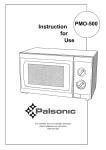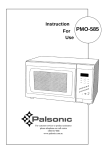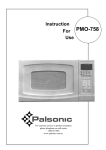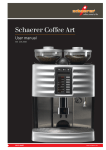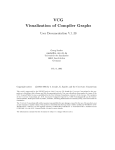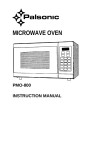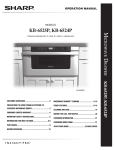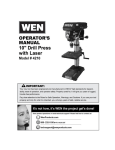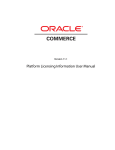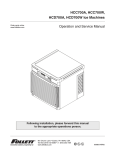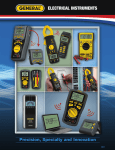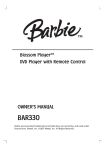Download Palsonic PMO-755 User's Manual
Transcript
Instruction For PMO-755 Use For customer service or product assistance please telephone our call centre 1300 657 888 www.palsonic.com.au ENGLISH Content Electrical connection Before you operate the oven Important when using your microwave oven Control panel Symbol description Oven overview Standard accessories Clock display Cooking interruption Time and power + 1 Minute Function page 1 1 2 3 3 3 4 4 5 5 6 page Defrost function Stage function Pizza / Popcorn function Bake potato function How to choose power level? Working with microwaves Maintenance Service Declaration of conformity Technical specifications Electrical connection 7 8 8 9 10 10 14 14 15 15 15 Electrical connection The earthing of this appliance is compulsory by law. The manufacturer will accept no responsibility for injury to persons or damage to objects arising from the non-observance of this requirement. Prior to connecting, check that the voltage on the rating plate corresponds to the voltage in your home. WARNING! THIS APPLIANCE MUST BE EARTHED Before you operate the oven Please read the instructions and guarantee information and keep for future reference. The packaging material is recyclable and marked with the symbol for recycling Please complete the guarantee card and send to our Service Department. Do not operate this appliance if it has a damaged mains cord or plug, if it is not working properly, or if it has been damaged or dropped. Electrical shock, fire or other hazards may result. Make sure that the appliance is not damaged. Check that the oven door closes firmly against the door support and that the internal door seal is not damaged. Empty the oven and clean inside it with a soft, damp cloth. Do not immerse the mains cord or plug in water. Keep the cord away from hot surfaces. Do not let the mains cord hang over edge of table or counter. Do not store or use this appliance outdoors. Do not use this product near a kitchen sink, in a wet basement, or near a swimming pool, or similar. Place the oven on a stable, even surface that is strong enough to hold the oven and the food utensils you put in it. The control side of the unit is the heavy side. Use care when handling. Do not use the cavity for storage purposes. Do not leave paper products, cooking utensils, or food in the cavity when not in use. Place the oven at a distance from other heating sources. The cooling air, which is taken in by the oven, must not exceed 35°C temperature. For sufficient ventilation there must be a space of at least 10 cm above the oven. Never lean on the door or allow a child to swing on it when the door is open. Injury could result. The ventilation openings on the oven must not be covered. Blocking the air intake or exhaust vents may cause damage to the oven and poor cooking results. Make sure the microwave oven feet are in place to ensure proper airflow. WARNING! The appliance should not be operated without food in the oven when using microwaves. Operating in this manner is likely to damage the appliance. If you practice operating the oven, put a glass of water inside. The water will absorb the microwave energy and the oven will not be damaged. The oven can be operated only if the oven door is firmly closed. Poor television reception and radio interference may result if the oven is located close to a TV, radio or aerial. 1 Important when using your microwave oven Do not use your microwave oven for cooking or reheating whole eggs with or without shell. Do not heat, store or use flammable materials in or near the oven. Fumes can create a fire hazard or explosion. Use this appliance only for its intended use as described in this manual. Do not use your microwave oven for heating food or liquids in airtight sealed containers. The pressure increases and may cause damage when opening or may explode. Do not use corrosive chemicals or vapours in this appliance. This type of oven is specifically designed to heat or cook food. It is not designed for industrial or laboratory use. Do not over-cook food. Fire could result. Some foods which has a low water content e.g. oil, chocolate and some pastries with sweet fillings, must be heated carefully. Do not use your microwave oven for drying textiles, paper, spices, herbs, wood, flowers, fruit or other combustible materials. Fire could result. Do not use your microwave oven for deep frying, because you cannot control the oil temperature. Do not leave the oven unattended, especially when using paper, plastic or other combustible materials in the cooking process. Paper can char or burn, and some plastics can melt if used when heating foods. As with any appliance, close supervision is necessary when used by children. One of the major advantages of microwave ovens is the short cooking time. Therefore, do not exceed recommended times for cooking or re-heating food. Always refer to a microwave cookbook for details. Especially, if cooking or reheating food that contains alcohol. Remove wire twist-ties from paper or plastic bags before placing bag in the oven. After heating baby food or liquids in a baby bottle, always stir and check the temperature before serving. This will ensure that the heat is evenly distributed and the risk of scalding or burns can be avoided. Ensure the Lid and the Teat is removed before heating! If material inside the oven should ignite, keep oven door closed, turn the oven off and disconnect, the power cord or shut off power at the fuse or circuit breaker panel. When heating liquids, e.g. beverages or water in your microwave oven, overheating the liquid beyond boiling point can occur without evidence of bubbling. This could result in a sudden boil over of the hot liquid. To prevent this possibility the following steps should be taken: 1. Avoid using straight-sided containers with narrow necks. 2. Stir the liquid before placing the container in the oven and let the teaspoon remain in the container. 3. After heating, allow to stand for a short time, stirring again before carefully removing the container from the oven. Use hot pads. Microwave energy does not heat containers, but the hot food does. Use oven mitts when touching containers, oven parts, and pan after cooking to prevent burns. 2 Controlpanel Clock button. Use this button to select the 24 hour clock and set the time of day. Digital display. This display includes a 12 hour clock and indicator symbols to tell you the time of day, cooking time, power level selected function etc. Power button. Press this button to set the desired microwave power level. Timer button. Touch this button followed by the keypad to enter cooking times. + 1 min button. Use this button to cook for one minute at full cook power or to add an extra minute to your cooking cycle. Defrost button. Use this button when defrosting. Keypad. Use the keypad to set the time and power needed for each function. Baked potato button. Use this button (the oven will automatically heat for a preset time at a preset cook power.) when baking potatoes. Popcorn / Pizza button. Use this button pop one bag of microwave popcorn or to cook one frozen pizza in your microwave oven (the oven will automatically heat for a preset time at a preset cook power). Start button. This button works as a normal start button after setting a function. Stop button. Use this button to stop or reset any of the oven functions. Door button. Use this button to open the door. Symbol description Clock symbol Microwave power symbol Popcorn / Pizza symbol Defrost symbol Function finished symbol Start symbol Baked potato symbol Stop symbol Timer symbol Oven overview Door symbol Rating plate Service Label Ventilation openings. Cabinet Door seals Control Panel Door glass Mains cord Door latches Door locks Turn table drive 3 Standard accessories Turn table support Glass turn-table Use the Turn table support under the Glass Turn-table. Never put other utensils than the Glass Turn-table directly on the Turn table support. The Turn table support may be cleaned in dishwashers. * Fit the Turn table support on its locator in the oven. Use the Glass Turn-table with all cooking methods. The Glass Turn-table collects the dripping juices and food particles that otherwise would stain and soil the interior of the oven. The Glass Turn-table may be cleaned in dishwashers. * Place the Glass Turn-table on the Turn table support. Clock display When the appliance is first plugged in or after a power failure, the display shows 88:88 Follow this procedure to set the clock. Note: The clock function is a 24 hour version. User action Oven reaction * The clock indicator is lit. 1. Press the CLOCK button 1 3 2. Enter the time of day on the keypad.. 2 3. Press the CLOCK button. * The Clock operates. 4 Cooking interruption To restart the cooking process: Close the door and press the START button. Note: The cooking process continues from where it was interrupted To interrupt the cooking process: If you wish to check, stir or turn the food just open the door and the cooking process automatically stops. When the door is opened the cooking time and functions remain set. If you open the door please consider the following: If you don’t want to continue cooking: Remove the food, close the door. Time and power Oven reaction User action 1. Press the TIMER button. * Maximum microwave power level is automatically set. 2. Enter the desired cooking time on the keypad. * The cooking time is dispalyed. 1 3 2 4 3. Press the MICRO button if a power level other than full power is desired. 5 4. Enter the desired power level on the keypad. 5. Press the START button. * The power level is displayed. * The cooking time is displayed counting down When the cooking time has elapsed an acoustic signal sounds and the cooking process is switched off. Note: Pressing the Power button once during cooking displays the current Power level for a few seconds. You can also change the power level during cooking by pressing the power button and enter a new level on the keypad. 5 + 1 min function Use this function for quick reheating of foods such as clear soups, coffee, tea or other foods with high water content. The + 1 min function lets you cook food for one minute for full cook power or add an extra minute to your cooking cycle. You can also use it to extend cooking time in multiples of one minute. Oven reaction User action 1. Press the + 1 min button. * The Power level is set to maximum. * The cooking time is displayed. 2. Press the START button. * The cooking time is displayed counting down. 1 When the cooking time has elapsed an acoustic signal sounds. 2 To extend cooking time in multiples of one minute, touch + 1 min repeatedly during cooking. Defrost function Your microwave oven has a defrosting function, which provides you with good end results. Oven reaction User action 1 1. Press the DEFROST button. * The defrost indicator is lit. 2. Enter the time needed to defrost the food. * The defrost time is displayed. 3. Press the START button. * The defrosting process begins. * The defrosting time is displayed counting down 2 3 When the Defrost program is finished an acoustic signal is heard 6 Stage function The Stage function is a temporary memory which is always ready to be reprogrammed when the cooking sequence is finished or the Stop button is pressed. You may select up to four stages to be run in sequence. We have chosen to describe a full sequence in order to show you the principle for handling the Stage function. Use the Stage function when you want to cook with different methods in sequence. It is excellent to use the second or third Stage as an automatic standing time function for foods which do well with a standing time after cooking. Simply enter a time and no power in the last Stage to achieve this. 1. Follow the DEFROST function procedure described earlier and instead of pressing the start button proceed with step two. When Stage 1 is finished an acoustic signal is heard and the oven immediately starts Stage 2. 3. Once more follow the TIME AND POWER function procedure described earlier. When Stage 2 is finished an acoustic signal is heard again and the oven immediately starts Stage 3 2. Follow the TIME AND POWER function procedure described earlier and instead of pressing the start button proceed with step three. When Stage 3 is finished an acoustic signal is heard and the oven switches off. 4. Press START button. * the Stage cooking process begins. Pizza / Popcorn function Popcorn: The popcorn function quickly cooks a bag of popcorn (100 g). The Pizza function quickly cooks a pizza (350 g). POPCORN Oven reaction: User action: 1. Press the PIZZA / POPCORN button. * "C" is displayed indicating popcorn. 2. Press START button. * The cooking process begins. * The cooking time is displayed. 1 When the Popcorn function is finished an acoustic signal is heard. 2 7 PIZZA User action: Oven reaction: 1. Press the PIZZA / POPCORN button twice. * "1" is displayed indicating pizza. 2. Press START button. * The cooking process begins. * The cooking time is displayed. When the Pizza function is finished an acoustic signal is heard. 1 2 Baked potato function The Baked potato function is designed for two potatoes weighing approximately 200 g each. User action: Oven reaction: 1. Press the BAKED POTATO button. * "0" is displayed indicating baked potato. 2. Press START button. * The cooking process begins. * The cooking time is displayed. 1 When Baked potato function is finished an acoustic signal is heard. 2 8 How to choose power level? P 10 P 3 - P2 - Fast reheat of beverages, water, clear soups, coffee, tea or other food with a high water content. If the food contains egg or cream choose a lower power. - To be used when simmering stews. Defrost - To be used for manual defrosting. P9-P8 P1 - To be used for cooking of vegetables, fish, meat etc. - To be used for softening butter, cheese and ice cream, or for defrosting sensitive food. P7-P6 - To be used when cooking dishes not possible to stir. P5-P4 - To be used when more careful cooking is required e.g. high protein sauces, cheese and egg dishes and to finish cooking casseroles. Working with microwaves Microwaves - what are they? Food always contains water. When we heat the food with microwaves the water molecules in the food are excited and heat is produced. The microwaves reach into the food and at the same time enters the food from all directions. Microwaves are like TV waves or light waves. You cannot see them, but you can see their effect. Just like ordinary daylight passes through glass, clear plastic and air, the microwaves have the ability to go through materials like paper, glass, porcelain, plastic and air. These materials do not contain water or metal and will consequently not be heated up by the microwaves. The microwaves are reflected by metal in the same way as light is reflected by a mirror. That’s why the food is heated so rapidly. You save time when cooking with a microwave oven. You usually also save energy, especially when cooking small amounts of food. If you boil fish in a sauce-pan with water, the electrical energy must first heat the hot-plate. The heat must transfer from the hot-plate to the sauce-pan and from the sauce-pan to the water which then will heat the fish. In a microwave oven the electrical energy is converted to microwaves and almost all of the microwave energy is then converted to heat inside the food Microwaves are absorbed by water, oil and fat. The water, oil and fat molecules are exited by microwaves and rub against each other, just like when you rub your hands quickly against each other and heat is produced. The speed of rubbing determines the temperature. Microwave energy is not hot. It simply causes the food to make its own heat. When we heat food with infra waves (Grill or hot air), in a normal oven, the heat is applied on the surface of the food and then conducts (transfers) to the centre of the food. Food has a rather poor ability to conduct heat and it therefore takes a long time to heat the food. Microwave heating Grill heating Cook time 20 - 25 min. 9 Cook time 10 min. Which utensils can be used in the oven? Utensils and cooking containers used in a microwave oven should be of a material that allows microwaves to pass freely through them. Generally this means that you should cook in either (paper), plastic, glass or ceramic. Utensils made of china and ceramic are excellent to use in your microwave oven. Most types of glass are also very good. Lead crystal glass can crack and should therefore, not be used. Coloured glass or glass with decorations shall be avoided since metal e.g. gold, might be part of the decoration and such decorations will be damaged. Plastics and paper can also be used, provided they can withstand the temperature of the heated food. For cooking only use plastics, which will withstand a temperature of over 1200 C Some plastic materials, e.g. melamine, will be heated by the microwaves, and be damaged. Round or oval shapes give the most even cooking. Square or rectangular containers may over-cook foods in the corners because more energy is absorbed there. Shallow containers give more even cooking results. Suitable Microwave cooking Material Glass (general) Glass (heat resistant) Glass-ceramic and ceramic (heat resistant) Earthenware China (heat resistant) Plastic (general) Plastic (heat resistant) Aluminium foil containers / aluminium foil Metal (pots or pans) Paper Yes (1) Yes Yes (1) Yes Yes Yes (2) Yes (2) Yes (3) No Yes 1. Without metal parts or metal trims. 2. Some plastics are heat-proof only to certain temperatures. 3. It is possible to use aluminium foil to shield delicate areas of food (this prevents over-cooking). To find out if a certain container is suitable, the following simple test can be made: Place the empty container and a glass of water inside the microwave oven. The water is needed because the oven must not be operated empty or with empty containers. Let the oven work on full power for one minute. A suitable container will only be lukewarm. Not suitable Metal containers, e.g. saucepans or frying pans should not be used in microwave ovens. Microwaves cannot penetrate metal. They will bounce off any metal object in the oven just as they bounce off the metal walls of the oven and cause “arcing”, a phenomenon that resembles lightning. Small pieces of aluminium foil can be used, but only to shield the areas that would over-cook (e.g. for covering chicken wings, leg tips and fish tails) but the foil must not touch the side of the oven as arcing (damage) may occur. CAUTION! There are a number of accessories avaliable on the market Before you buy, make sure they are suitable for microwave use. When you put food in the microwave oven, make sure that food, food supports or covering do not come in direct contact with any of the internal walls or the ceiling of the cavity. Aluminium foil containers and microwaves * Aluminium foil containers should always be used singly in a microwave oven, and placed on the glass turn-table provided. * Follow the instructions provided by the food producer to ensure thorough heating of the food product throughout. If you are using a foil container for self produced foods they * may take longer to heat than when using plastic, glass, porcelain or paper containers. Always ensure the food is piping hot (minimum 720 C) before serving. A useful tip is to place the foil container in a heat resisting glass or plastic bowl, adding some hot water (not more than 1 cm deep) to provide heating for the foil container base. Stir if appropriate or let the food stand for 2-3 minutes after heating, to assist heat distribution within the container. It is now possible to use disposable aluminium foil containers in this new generation of microwave ovens, providing these simple rules are followed: * Always remove foil-laminated fibre board lid from the container before heating, otherwise oven damage can occur. * Only undamaged foil containers may be used. * Aluminium foil containers with a height exceeding 3 cm should be avoided and the container must be at leas t 2/3 full. * There must be a minimum of 1 cm between the aluminium foil container and the walls of the oven, to avoid sparking. 10 Hints Sugar: When cooking foods with a high sugar or fat content, such as Christmas pudding, mince pies and fruit cake follow the recommended cooking instructions carefully. Exceeding the recommended cooking times may result in burning of the food and damage to the oven. Releasing pressure in foods Several foods are tightly covered by a skin or membrane. These foods should be pricked with a fork or cocktail stick to relieve the pressure and to prevent bursting, as steam builds-up within them during cooking. This applies to jacket potatoes, potatoes, chicken livers, sausages, egg yolks and some fruits. Points to remember when defrosting manually * The shape of the package alters the defrosting time. Shallow rectangular packets defrost more quickly than a deep block. * Separate pieces as they begin to defrost; free-flow slices defrost more easily. * Shield areas of food with small pieces of foil if they start to become warm. Wooden toothpicks may be used to hold the foil in place. * When defrosting, it is better to under-thaw the food slightly and allow the process to finish during the standing time. The amount of food The more food you want to prepare the longer it takes. A rule of thumb is that double amount of food requires almost double the time. If one potato takes four minutes to cook, approximately seven minutes are required to cook two potatoes. Standing time Always allow the food to stand for some time after using the oven. Standing time after defrosting, cooking/reheating always improves the result since the temperature will then be evenly distributed through out the food. In a microwave oven foods continue to cook even when the microwave energy is turned off. They are no longer cooked by microwaves, but they are still being cooked by the conduction of the high residual heat to the centre of the food. The length of the standing time depends on the volume and density of the food. Sometimes it can be as short as the time it takes you to remove the food from the oven and take it to the serving table. However, with larger, denser foods, the standing time may be as long as 10 minutes. The food will finish cooking during this time. Moisture content: Because microwaves are attracted to moisture, cooking time will vary according to water content. Naturally moist foods such as vegetables, fish and poultry will cook quickly and evenly; drier foods such as rice or dried beans require added moisture for microwave cooking. Condensation: Humidity and moisture in foods will sometimes cause condensation on the walls of the oven or inside the door. This is normal with cooking. Generally, covered foods will cause less condensation than uncovered foods. Arranging Food When you cook or reheat whole fish, score the skin - this prevents cracking. The best results are achieved if the food is evenly distributed on the plate. This is done in several ways in microwave cooking to give more even cooking results. If you are cooking several items of the same food such as jacket potatoes, place them in a ring pattern for uniform cooking. Shield the tail and head with small pieces of foil to prevent over-cooking but ensure the foil does not touch the sides of the oven. When cooking foods of uneven shapes or thickness, place the smaller or thinner area of the food towards the centre of the dish where it will be heated last. Composition of the food Food with a lot of fat and sugar will be heated faster than food containing a lot of water. Fat and sugar will also reach a higher temperature than water in the cooking process. The more dense the food, the longer it takes to heat. “Very dense” food like meat takes longer time to reheat than lighter, more porous food like bread. Uneven foods such as fish should be arranged in the oven with the tails to the centre. If you are saving a meal in the refrigerator or “plating” a meal for reheating, arrange the thicker, denser foods to the outside of the plate and the thinner or less dense foods in the middle. Size and shape Smaller pieces of food will cook faster than larger pieces and uniform pieces of food cook more evenly than irregularly shaped foods. To ensure even cooking, cut all pieces of food into similar sizes and shapes. Place thin slices of meat on top of each other or interlace them. Thicker slices such as meat loaf and sausages have to be placed close to each other. Gravy or sauce should be reheated in a separate container. Stirring, turning of foods during cooking Stirring and turning of foods are techniques used in conventional as well as in microwave cooking to distribute the heat quickly to the centre of the dish and avoids over-cooking at the outer edges of the food. turning foods is especially important here because it allows for more even cooking. As in conventional cooking, foods such as roasts need to be elevated so they are not allowed to steam in their own juices. Choose a tall, narrow container rather than a low and wide container. When reheating gravy, sauce or soup, do not fill the container more than 2/3 11 COOKING CHART Food BEEF 1 lb (500g) ground beef 1 lb (500g) meatballs 1 lb (500g) hamburgers 1 lb (500g) meat loaf Steaks PORK Bacon 1/2 lb (225g) pork sausages, raw Pork chops Pork roast LAMB Cooking time Power level 3-5 minutes P - 10 P - 10 9-12 minutes P - 10 4-5 minutes P - 10 15-20 minutes P - 10 2-4 minutes per lb (500g) P - 10 1/2-3/4 minutes per slice P - 10 P - 10 P - 10 2-4 minutes 10-12 minutes per lb (500g) 10-12 minutes per lb (500g) Roast leg or shoulder VEAL Roast shoulder P-9 8-10 minutes per lb (500g) P-9 9-10 minutes per lb (500g) Lamb/veal cutlets/chops (3-4 pieces) P - 10 6-8 minutes POULTRY Chicken pieces Whole chicken Stewing, cut up Turkey breasts P - 10 P - 10 P-8 2-3 minutes per piece 9-10 minutes per lb (500g) 12-14 minutes per lb (500g) P-8 8-9 minutes per lb (500g) 1 lb (500g) fillets/steaks P - 10 1 lb (500g) whole fish EGGS Scrambled Poached P - 10 7-9 minutes 7-9 minutes FISH Omelette P - 10 1-2 minutes per egg 1-2 minutes per egg 3/4-1 1/2 minutes to melt butter 1-2 minutes per egg P - 10 P - 10 Custard (8x8 in) P-8 15-19 minutes P - 10 8-19 minutes P - 10 8-16 minutes P - 10 P - 10 5-5 1/2 minutes 4-6 minutes P - 10 P - 10 P - 10 1-2 minutes 2-5 minutes P - 10 P - 10 9-12 minutes 5-6 minutes Cupcakes (6) Bar cookies 8 in (20cm) square dish P - 10 P-6 P-8 5-5 1/2 minutes 2-2 1/2 minutes SOUP/BEVERGE 1 cup water based 1 cup milk based P - 10 P-8 (20x20 cm) VEGETABLES Vegetables (1-2 lb) (500-1000g) water 1/4 cup Potatoes (1 lb) (500g) baked Corn-on-the-cob - fresh husk 2 - frozen 2 CEREAL 1/2 cup quick oatmeal, water 1 cup 1/2 cup long cooking oatmeal, water 1 cup 1/2 cup cornmeal, water 2 cups CAKES Carrot cake (10x6 in) (25cm x 15cm) Basic butter or chocolate 8-1/2 in (21cm) round dish Ring cake 2-3 minutes 3-6 minutes 1-2 minutes 1-2 minutes 12 DEFROSTING CHART Food MEAT Recommended Time Suggestions 1 pack bacon 2-3 1/2 minutes Leave packages unopened when defrosting. Microwave till foods can be separated. " " Frankfurters 2-3 1/2 minutes per lb (500g) Spare-ribs Ground meat 5-6 minutes per lb (500g) 6-8 minutes per lb (500g) Roast beef 4-6 minutes per lb (500g) Pork Lamb Steaks, chops and cutlets Sausages 7-9 minutes per lb (500g) 7-9 minutes per lb (500g) Unwrap roast and place in cooking dish. Defrost till half of defrosting time and turn it over. Stand for ten minutes " " 3-6 minutes per lb (500g) 3-4 minutes per lb (500g) Separate pieces after half of defrosting time. Turn over after half of defrosting time. Turn over after half of defrosting time. POULTRY 1 whole chicken (2 1/2-3 1/2 lb) (1 1/4-1 1/2 kg) 13-16 minutes Place wrapped whole bird in oven when defrosting. Turkey 6-8 minutes per lb (500g) Chicken pieces 4-6 minutes per lb (500g) " Separate during half of defrosting time. Stand to complete defrosting Turkey parts 6-8 minutes per lb (500g) " FISH AND SEAFOOD 1 lb (500g) fillets 6-7 minutes Leave package unopened when defrosting. Stand in cold water to separate 1 lb (500g) steaks 1-2 minutes No manipulation 8-10 oz (225-282) whole fish 2-4 minutes Place fish in cooking dish. Turn over once half way through defrosting time. Rinse cavity of fish with cold water. 1 lb (500g) small pieces of seafood, e.g. shellfish, shrimps, crab meat, oysters, etc. 4-6 minutes 6-9 oz (170-255g) lobster tails 4-6 minutes 1 1/2 lb (750g) whole lobster or crab BREAD AND CAKES 12-13 minutes Break-up after half of defrosting time. No manipulation Turn over after half of defrosting time 7 oz-1 lb (190-500g) bread, buns, rolls Doughnuts 12-17 oz (340-482g) pound cake/coffee cake, frosted, cream filled, or topped 17-19 oz (482-539g) cheesecake 8 in (20 cm) fruit or nut pie 14 oz (395g) cream or custard pie Cup cakes VEGETABLES 1-3 minutes 1/4 minute each 1-3 minutes 3-5 minutes 6-7 minutes 1-2 minutes 1/4/3/4 minute Vegetables are preferably cooked from frozen. Add 1-2 tablespoons of water RE-HEATING CHART 1 serving 1-2 servings 2-4 servings 2-3 servings 2-3 servings 2 servings 2 servings 1-2 ears 2-3 1 1-2 slices 3-4 4 Food Plate of food Saucy main dish Thick meat slices, such as hamburaers. meat loaf slices Thin meat slices, such as beef, ham, pork, turkey Chicken pieces Casserole Vegetables Corn-on-the-cob Rolls Whole pie Pie Sausages Hot dogs Power level P - 10 Cooking time P - 10 P - 10 P-8 7-9 minutes 3-5 minutes P-9 P-8 P - 10 P - 10 13 2-3 minutes 2-3 minutes 3-4 minutes 9-12 minutes 3-4 minutes P - 10 P - 10 P - 10 3-4 minutes 3/4-1 minute 3-7 minutes 1-2 minutes P - 10 P - 10 1-2 minutes 1-2 minutes Maintenance Cleaning is the only maintenance normally required. It must be carried out with the microwave oven disconnected. For stubborn soil, boil a cup of water in the oven for 2 or 3 minutes. Steam will soften the soil. Do not use metal scouring pads on the inside of the oven cavity. They will scratch the surface. Odours inside the oven can be eliminated by placing a cup of water with lemon juice added into the oven and boiling the mixture. Important: The door seals and the door seal areas must be regularly inspected for damage. If these areas are damaged the appliance should not be operated until it has been repaired by a service technician trained by the manufacturer. At regular intervals, especially if spillovers have occurred, remove the turn-table and wipe clean the base of the oven. This oven is designed to operate with the turn-table in place. WARNING! Do not operate the microwave oven when the turn-table is removed for cleaning. Use a mild detergent, water and a soft cloth to clean the interior surfaces front and rear of the door and the door opening. Abrasive cleaners, steel-wool pads, gritty wash cloths, etc can damage the control panel, and the interior and exterior oven surfaces. Use a sponge with a mild detergent or paper towel with spry glass cleaner. Apply spray glass cleaner to paper towel. Do not spray directly on the oven Do not allow grease or food particles to build up around the door. Service If the oven does not work, do not make a service call until youhave made the following checks: * The Turn-table and turn-table support is in place. * The Plug is properly inserted in the wall socket. * The Door is properly closed. * Check your Fuses and make sure that there is power available. * Wait for ten minutes and then try to operate the oven once more. Important: If the mains cord needs replacing it should be replaced by the original mains cord which is available via our service organisation. The mains cord must only be replaced by a trained service technician. WARNING! Service only to be carried out by a service technician trained by the manufacture. It is dangerous for anyone other than a service technician trained by the manufacture to perform repair service. This is to avoid unnecessary calls for which you will be charged. When calling for Service, please give the serial number and type number of the oven (see Service label). 14 Technical specification PMO-755 Model 240V / 50Hz Supply voltage 1330 W Current consumption 8A Fuse Microwave power (acc. to IEC 705 1000g water) Full power 800 W Electronic Timer Dimensions (Height x Width x Depth) in mm Outside dimensions 298 x 492 x 359 Oven cavity dimensions 195 x 300 x 320 This publication indicates basic characteristics subject to change without notification and is not binding for our organisation or our representatives. 15 Palsonic WARRANTY altered or removed; the unit must not have been subject to accident, misuse, abuse, undue wear and tear, dirt, neglect, or operated contrary to the instructions contained in the accompanying manual. The warranty does not apply to loose accessories. PALSONIC CORP. PTY. LTD. subject to the terms and conditions hereinbelow expressly set forth in paragraphs number "1" through "7" HEREBY WARRANTS that for a period of 12 months from the date of original purchase at retail it will repair or replace any part of the enclosed unit which proves defective by reason of improper workmanship and/or material, without charge for parts or labour. 1. Registration: The enclosed warranty registration card must be mailed to PALSONIC CORP. PTY. LTD. P.O. BOX 372, WATERLOO, NSW 2017 within 10 days from the date of purchase. 5. Should the unit be damaged or become faulty due to being operated on a supply voltage other than specified on the product or in the manual this warranty is invalid. 2. Original Purchaser: This warranty is limited to the original purchaser of the unit at retail. When requesting warranty service, proof of purchase must be submitted. A copy of the enclosed warranty registration card or sales receipt may be used for this purpose. Warranty does not apply if the unit is repossessed under any financing agreement. 3. Proper Delivery: The unit must be shipped, freight prepaid, or delivered to a facility authorised by PALSONIC CORP. PTY. LTD to render the services provided hereunder in either its original package or a similar package affording an equal degree of protection. 4. Unauthorised Repair, Abuse etc: The unit must not have been previously altered, repaired or serviced by anyone other than a service facility authorised by PALSONIC CORP. PTY. LTD. to render such service; the serial number on the unit must not have been 6. The warranty covers the unit for normal household or domestic purposes. Units used in any other situation, commercially or for demonstration purposes shall have warranty limited to 90 days. 7. The warranty for this unit is valid only within Australia and New Zealand. EXCEPT TO THE EXTENT PROHIBITED BY LAW NO OTHER WARRANTIES, WHETHER EXPRESS OR IMPLIED, INCLUDING WARRANTIES OR MERCHANTIBILITY AND FITNESS FOR A PARTICULAR PURPOSE, SHALL APPLY TO THIS UNIT. UNDER NO CIRCUMSTANCES SHALL PALSONIC CORP. PTY. LTD. BELIABLE FOR CONSEQUENTIAL DAMAGES SUSTAINED IN CONNECTION WITH THE SAID UNIT AND PALSONIC CORP. PTY. LTD. NEITHER ASSUMES NOR AUTHORISES ANY REPRESENTATIVE OR OTHER PERSON TO ASSUME FOR IT ANY OBLIGATION OR LIABILITY OTHER THAN SUCH AS IS EXPRESSLY SET FORTH HEREIN. CONGRATULATIONS ON YOUR CHOICE OF A PALSONIC PRODUCT KEEP THIS CARD FOR YOUR RECORDS: (It is a good idea to attach your purchase receipt to this card) SERIAL NO: MODEL NO: PMO-755 DATE OF PURCHASE NAME OF STORE WHERE PURCHASED: SUBURB OR LOCATION OF STORE: IMPORTANT: Fill in the Warranty Registration Card below, tear off and send to Palsonic Corp. Pty. Ltd., 1Joynton Avenue, Waterloo, NSW, 2017, (02) 9313 7111 Palsonic WARRANTY REGISTRATION Please complete and mail this card within 10 days of purchase to assure registration of your warranty. YOUR NAME: (Please Print) YOUR ADDRESS: STATE: POSTCODE: DATE OF PURCHASE: NAME OF STORE WHERE PURCHASED: YOUR TELEPHONE NO: SUBURB OR LOCATION OF STORE: MODEL NO: PMO-755 PRODUCT SERIAL NO: To be mailed PALSONIC CORPORATION PTY LTD, 1 JOYNTON AVENUE, WATERLOO NSW 2017 4619-651-97661 PALSONIC CORPORATION PTY LTD 1 JOYNTON AVENUE WATERLOO NSW 2017 AUSTRALIA TEL:(02)9313 7111 FAX:(02)9313 7555 www.palsonic.com.au PALSONIC CUSTOMER SERVICE TELEPHONE AUSTRALIA: 1300 657 888



















